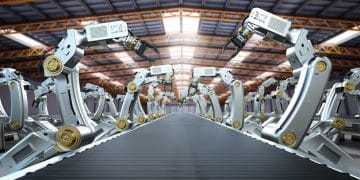Labor Shortage Solutions: Innovative Strategies US Companies Are Using

US companies are implementing innovative labor shortage solutions, including enhanced benefits, skills development programs, and technology adoption, to attract and retain talent in a competitive market.
Facing unprecedented labor shortages, US companies are proactively seeking labor shortage solutions to attract and retain skilled workers, adapting their strategies to meet the evolving demands of the workforce.
Understanding the US Labor Shortage
The United States has been grappling with a significant labor shortage across various sectors. This shortage isn’t just a temporary hiccup; it’s a multifaceted issue stemming from demographic shifts, skills gaps, and changing worker expectations. Understanding the root causes is critical for businesses looking to navigate this challenging landscape.
Demographic Shifts and Retirement
One of the primary drivers of the labor shortage is the aging workforce. As Baby Boomers retire, they’re taking decades of experience with them, leaving gaps that are difficult to fill.
Skills Gap and Educational Mismatch
Another significant factor is the mismatch between the skills that employers need and the skills that job seekers possess. Rapid technological advancements require specialized skills, and many educational institutions haven’t kept pace.

These factors, among others, are contributing to a perfect storm in the labor market, forcing companies to rethink their approaches to talent acquisition and retention.
Enhanced Compensation and Benefits Packages
One of the most direct ways to attract and retain talent is by offering competitive compensation and benefits. This goes beyond just a base salary; it includes health insurance, retirement plans, paid time off, and other perks that enhance an employee’s overall well-being and financial security.
Sign-on Bonuses and Retention Bonuses
Many companies are using sign-on bonuses to attract new employees and retention bonuses to keep existing ones. These bonuses can be particularly effective in high-demand industries.
Comprehensive Health and Wellness Programs
In today’s workforce, health and wellness are paramount. Companies that offer comprehensive health insurance plans and wellness programs, such as mental health support, gym memberships, and wellness challenges, are more likely to attract and retain talent.
- Competitive Salaries: Regularly benchmark salaries against industry standards.
- Health Insurance: Offer comprehensive and affordable health insurance options.
- Retirement Plans: Provide robust retirement savings plans with employer contributions.
- Wellness Programs: Implement programs that promote physical and mental well-being.
By prioritizing compensation and benefits, companies can demonstrate their commitment to their employees’ well-being, making them more attractive employers.
Investing in Employee Training and Development
Another effective strategy for addressing the labor shortage is investing in employee training and development. By providing opportunities for employees to learn new skills and advance their careers, companies can not only attract talent but also improve productivity and morale.
Upskilling and Reskilling Programs
Upskilling involves enhancing an employee’s existing skills, while reskilling involves training them for a new role altogether. Both types of programs can help bridge the skills gap and create a more versatile workforce.
Mentorship and Leadership Development
Mentorship programs pair experienced employees with newer ones, providing guidance and support. Leadership development programs prepare employees for future leadership roles within the company.

Investing in employee training and development not only benefits the employees themselves but also strengthens the company as a whole.
Leveraging Technology to Improve Efficiency
Technology can play a crucial role in addressing the labor shortage by improving efficiency and reducing the need for manual labor. Automation, artificial intelligence, and other technologies can streamline processes and free up employees to focus on more strategic tasks.
Automation and AI
Automation can handle repetitive tasks, while AI can provide insights and make data-driven decisions. Implementing these technologies can significantly increase productivity and reduce the workload on employees.
Remote Work and Collaboration Tools
Remote work has become increasingly popular, and companies that offer remote work options can attract a wider pool of candidates. Collaboration tools make it easier for remote teams to communicate and work together effectively.
- Automation: Implement automation solutions to streamline repetitive tasks.
- AI: Use AI to improve decision-making and optimize processes.
- Remote Work: Offer remote work options where possible.
- Collaboration Tools: Provide tools that facilitate communication and collaboration.
By embracing technology, companies can not only address the labor shortage but also improve their overall competitiveness and innovation.
Creating a Positive and Inclusive Workplace Culture
A positive and inclusive workplace culture is essential for attracting and retaining talent. Employees want to work for companies that value diversity, equity, and inclusion, and that foster a sense of belonging.
Diversity, Equity, and Inclusion (DEI) Initiatives
DEI initiatives promote fairness and equal opportunity for all employees, regardless of their background. These initiatives can include diversity training, mentorship programs, and inclusive hiring practices.
Employee Recognition and Appreciation
Companies can show their appreciation for their employees’ hard work by recognizing their achievements and contributions. This can include awards, bonuses, and public acknowledgment.
Creating a workplace culture that values and supports all employees is crucial for attracting and retaining talent in today’s competitive market.
Flexible Work Arrangements and Work-Life Balance
Employees increasingly value work-life balance, and companies that offer flexible work arrangements are more likely to attract and retain talent. Flexible work arrangements can include remote work, flexible hours, and compressed workweeks.
Remote Work Policies
Remote work allows employees to work from home or other locations, providing greater flexibility and autonomy.
Flexible Hours and Compressed Workweeks
Flexible hours allow employees to adjust their start and end times, while compressed workweeks allow them to work longer hours over fewer days.
- Remote Work: Offer remote work options where feasible.
- Flexible Hours: Allow employees to adjust their start and end times.
- Compressed Workweeks: Offer the option to work longer hours over fewer days.
- Paid Time Off: Provide generous paid time off policies.
By prioritizing work-life balance, companies can create a more appealing work environment and attract and retain top talent.
Focus on Employee Well-being
An integral component of retaining workers is a clear focus on the physical as well as mental well-being of employees. A few ways to ensure the wellness of employees and improve retention include support for mental health, access to healthcare resources, and flexible work hours.
Mental Health Support
Companies seeking to support employees’ mental health should offer wellness programs with resources such as in-house or in-network therapists. Employees should feel no stigma for leveraging mental health resources when needed.
Accessible Healthcare
Aside from mental wellness, overall healthcare is vital to wellness. Companies can help improve access by providing the best plans at a reasonable cost so more employees use them.
Companies that successfully focus on employees’ well-being are better positioned to weather the labor shortage and keep their workers satisfied, improving retention.
| Key Point | Brief Description |
|---|---|
| 💰Competitive Pay | Offers competitive salaries and benefits to attract top talent. |
| 📚Training Programs | Invests in upskilling and reskilling to bridge the skills gap. |
| ⚙️Technology Adoption | Leverages automation and AI to improve efficiency. |
| 🤝Positive Culture | Fosters an inclusive and supportive workplace environment. |
FAQ
▼
The labor shortage is driven by demographic shifts, skills gaps, and evolving worker expectations, including remote work options.
▼
Companies can improve employee retention by offering competitive compensation, flexible work arrangements, and investing in their well-being.
▼
A positive workplace culture attracts and retains employees, fostering a sense of belonging and job satisfaction.
▼
Technology improves efficiency through automation and AI, reducing the need for manual labor and streamlining processes for current workers.
▼
Training programs prepare employees for current and future roles, leading to upskilling, reskilling, and leadership development for staff.
Conclusion
In conclusion, US companies are employing a range of innovative strategies to combat the labor shortage to attract and retain talent. By focusing on enhanced compensation, employee development, technological advancements, and a positive workplace culture, businesses can navigate the challenges of the current market and secure a skilled and engaged workforce.





